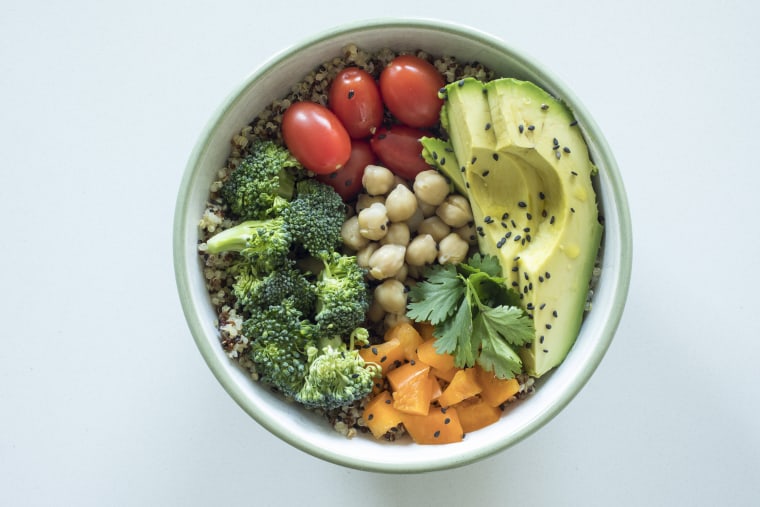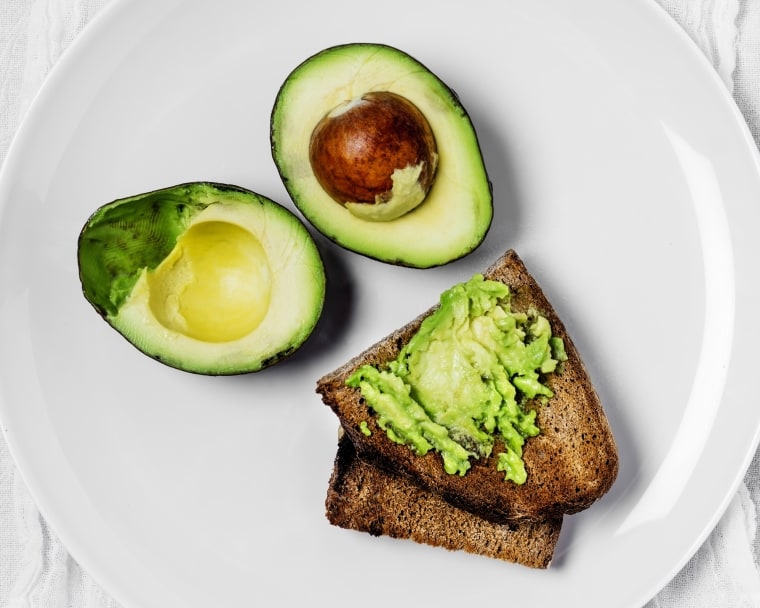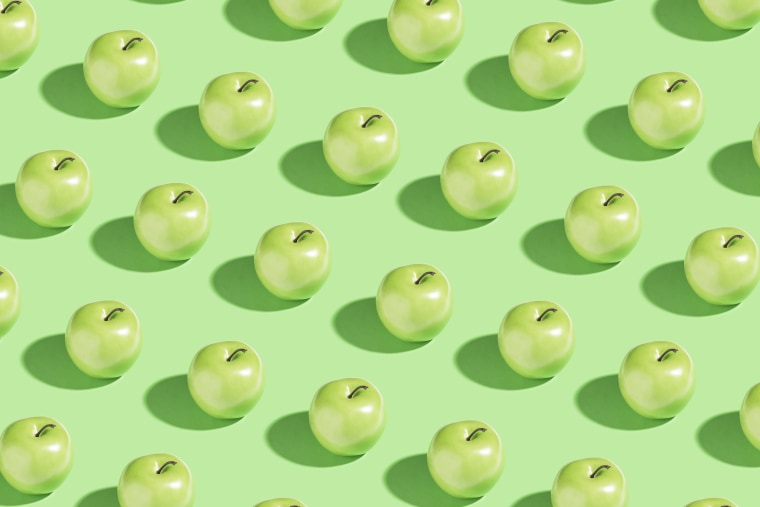If you think all registered dietitians — the credentialed pros responsible for doling out food and nutrition information — eat the same, you might be in for a surprise. Below is a peek at what four different RDs eat on a typical day, proving yet again that nutrition isn’t one size fits all.
The protein and fiber worshipper
Here's a sneak peek into my daily diet:
Pre-breakfast: Coffee with a scoop of collagen powder and 2 percent milk
I’m intrigued by research suggesting some benefit to tendons, joints, and skin by supplementing with collagen powder. While the science is early and inconclusive, the potential upside (less pain and stiffness, more youthful skin) is enough to sway me.
Breakfast: Smoothie
Fruit (such as mango, blueberries, or cherries), blended with fresh baby spinach, a healthy fat (such as tahini, chia seeds, or avocado), and a sprinkle of antioxidant-rich spices, such as cinnamon or ginger.
I don’t eat breakfast until a few hours after I wake up, but when I do, I want to fill up. I love starting my day knowing that I’ve already scored several servings of produce because it gives me a sense of accomplishment. Plus, a smoothie is a balanced meal that keeps me satisfied, energized, and focused.
Lunch: A big salad
Generous serving of pre-washed greens (such as arugula, romaine or spinach) with leftover roasted veggies (maybe broccoli or Brussels sprouts), leftover chicken or a couple of soft boiled eggs, chickpeas, a sprinkle of nuts, and a quick and easy homemade dressing.
I use a basic blueprint that consists of a huge portion of veggies along with protein and healthy fats, but the ingredients change day-to-day. I also adjust portions and ingredients depending on my hunger, say, by skipping the chickpeas if my appetite is on the lighter side.

Snack: An apple with tahini or grapes with a small piece of cheese
Dinner: Ground chicken taco salad
Ground chicken seasoned with taco seasonings, generous serving of leafy greens, black beans, avocado, salsa and a few crushed tortillas on top.
Another formulaic meal here: I always make one main-dish protein, a starchy-carb side dish, and one or two types of roasted veggies. From there, I mix and match portions for me and my 15-year-old son since we have very different needs. For example, on taco night, I have a taco salad but he has his in a whole grain corn taco shell with lettuce and cheese along with a generous serving of roasted veggies (I’m talking half a plate here).
Dessert: A couple of squares of dark chocolate and some frozen, sliced bananas along with a cup of herbal tea.
Key takeaways: Every meal includes generous helpings of veggies, and snacks are also heavy on produce. Heaping portions of veggies provide ample fiber and make meal times more filling. Protein is balanced across meals, which helps keep hunger away and keeps muscles healthier as you age. And meals and snacks are customized based on hunger — more or less food, depending on the day.
The Circadian-Synced Diet
Tamara Duker Freuman, MS, RD, CDN, author of "The Bloated Belly Whisperer"
Breakfast: Latte and avocado toast
Latte made with frothed 2 percent lactose-free milk and two shots of espresso
Two slices Canyon Bakehouse gluten free toast, ½ mashed avocado, and one sliced tomato
Alternative breakfast: Toast with with one-and-a-half slices muenster cheese and a sliced baby cucumber.
Freuman eats within an hour of waking.

Snack: Two or three clementines or an apple or a handful of dry roasted chickpeas
Freuman goes a long stretch between breakfast and lunch so a mid-morning snack tides her over until she can break for another meal.
Lunch: Mexican-style salad
A bed of arugula topped with black beans, pickled red onions, tomato, pepper, avocado and leftover protein (brisket, grilled chicken).
If leftovers aren’t an option, Freuman uses Pacific Foods Sante Fe Style Chicken Soup and doctors it up with a handful of crushed tortilla chips and some sliced avocado (or she swaps the avocado for some cheddar cheese) for what she calls a “cheater's tortilla soup.”
Dinner: Turkey pesto meatballs with marinara sauce
Meatballs with marinara sauce are served over a sizable bed of cooked spinach or spaghetti squash with Parmesan cheese
“Five days a week I have some combo of protein and vegetable. The other two days I include a carb with dinner,” explains Freuman, who says that while she skips the starch, the rest of the family will have their meatballs with some pasta.
“Every Friday night, my meal is the same: steak or brisket with a buttered, yukon gold potato and roasted cauliflower,” she says. “I absolutely love baked potatoes with butter so I make room for that at dinner once a week.”
Key takeaways: Freuman front loads carbs and calories at breakfast and lunch. “I find it helps control hunger at night to eat a relatively large lunch with some healthy carbs, and I find myself less likely to need an after dinner snack when I front load well. I often suggest this pattern of eating to my patients seeking weight loss, blood sugar and/or cholesterol management, as there’s good data suggesting it can be beneficial for all these things,” she explains.
The carb lover
Keri Gans, RDN, nutritionist and author of "The Small Change Diet"
Breakfast: Oatmeal
Quick-cooking oats made with non-fat milk, chia seeds, and natural chunky almond butter (about 1 Tbsp each), plus a glass of 1/4 cup orange juice, 3/4 cups seltzer, and black coffee.
Gans, an avid yogi and certified teacher, enjoys breakfast first-thing in the morning. “Even on days when I do a yoga class in the morning, I always eat first before anything else,” she says. Starting her day off right means getting some fluids. “I really like to try and start my day with hydration, and for some reason a regular cup of water doesn’t do it here,” which is why she goes for her mix of OJ and seltzer (diluted to reduce the acidity and because she enjoys the taste).
Lunch: Bagel and eggs
Whole wheat bagel scooped (or 100 percent whole-grain bread), toasted and smeared with tofu scallion cream cheese, 1/4 avocado, two eggs (scrambled, fried or poached), and tomato slices. Lunch is served with a 6-ounce container of blackberries (or an alternative piece of fruit) and more coffee.
If you’re wondering how Gans gets away with eating so many carbs, she says portion control is key. “I Iove my carbs so instead of eliminating them, I’ve found a way to still enjoy them but in a healthier way,” she explains when asked about her scooped out bagel.
Snack: One string cheese and four Taralli Italian crackers
“Sometimes I skip the snack and just eat my dinner salad earlier,” says Gans.
Dinner: Pasta
Bow-tie pasta tossed with shrimp (or beans), sautéed Brussels sprouts, peas, garlic, basil, ground pepper and parmesan cheese served with a mixed green salad (usually little gem lettuce, grape tomatoes and red onion) with store-bought salad dressing. To drink: 1 extra-dry martini with olives.
Gans eats regular white pasta instead of the often-recommended whole grain version. “I like it better,” she says, “so I go with what I enjoy.”
Key takeaway: Gans finds healthier ways to enjoy her favorite carb-rich foods by right-sizing portions and balancing out meals with other healthful fare. Plus, she keeps snacking to a minimum. “I think that for many, snacking is simply a habit,” she explains. Gans recommends assessing between-meal hunger and identifying any long gaps between meals (say, four to six hours), in which case, a snack may be in order. “Anything less than that, I try to see if clients are eating a balanced enough meal beforehand to hold them over.” She also suggests most people skip an after-dinner snack, unless dinner is on the early side. “For most people who eat dinner after 7 PM, they just need to go to bed earlier.”
The macro counter
Emily Field, RD is in private practice teaching a macro-based, balanced eating approach.
Breakfast: Eggs
Scrambled eggs served with Canadian bacon or turkey sausage, assorted veggies, salsa, and sauerkraut.
This meal hits all the macros: protein from eggs, meat and collagen; fat from egg yolks and cooking oil, and carbs from vegetables. “I add kimchi, sauerkraut or raw sriracha for a little dose of probiotics,” says Field.
Lunch: Tuna salad
Tuna mixed with stone ground mustard, mayo (full fat), garlic, onion, and celery atop a bed of lettuce tossed with cherry tomatoes, bell peppers, and other raw veggies.
“All the vegetables take up a ton of room in my stomach, which translates to a meal that fills me up and satisfies me for hours.”
Snack: Apple and peanut butter or jerky and dried fruit
Field makes sure her snacks include a mix of protein and fat or carbs. She notes that most vending machine and office pantry items are predominantly carb-based, which aren’t as filling.
Dinner: Stir-Fry
Sliced flank steak cooked in oil, rice, and riced cauliflower along with a mix of frozen stir-fry veggies.
Key takeaways: Macro-based eating is a structured, yet flexible system of creating enjoyable meals based on whole food ingredients. A dietitian, like Field, can help customize macro targets based on your needs and goals and from there, you have the freedom to create meals based on foods you enjoy that fit within the framework. “Eating this way keeps me full and satisfied, avoiding cravings or munchy feelings, and feeling energized all day long,” says Field.
WHAT A NUTRITIONIST WANTS YOU TO KNOW
- Bad nutrition advice dietitians want you to forget
- The best way to lose weight boils down to these three things
- What you need to know about going vegan
- The healthiest meals at top fast food chains
Want more tips like these? NBC News BETTER is obsessed with finding easier, healthier and smarter ways to live. Sign up for our newsletter and follow us on Facebook, Twitter and Instagram.


